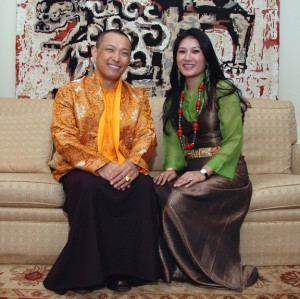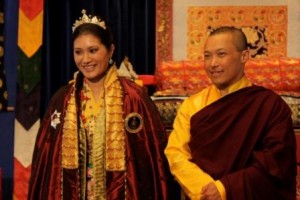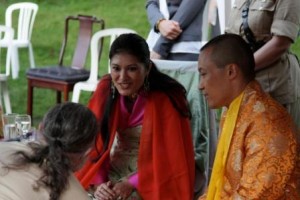Saturday
Sakyong and FamilyA Buddhist Marriage
In our first article commemorating the one-year anniversary of the Sakyong Wangmo empowerment, we offer a piece by Melvin McLeod, editor-in-chief of Shambhala Sun magazine. Last fall, Melvin spoke to Sakyong Mipham and Khandro Tseyang about their own marriage and how all of us can bring the teachings of Buddhism and Shambhala into our relationships.
Shambhala Sun: Is a relationship itself a form of spiritual practice?
Sakyong Mipham Rinpoche: Relationship is the training ground for practice, and it’s also the place where your practice is tested. If you’re trying to practice compassion, a relationship will show you how well you’re dealing with your own mind. Sometimes there’s a big gap between theory and practice. Outside, you can pretend you’re practicing compassion, but when you’re trying to practice compassion with the people who are close to you, you see how theoretical it is. Family is the heaviest karmic situation; your own character and practice are at stake all the time. You have to be a really talented practitioner in order to do it well.
Khandro Tseyang: As a Buddhist practitioner, my practice on the path helps a great deal in maintaining our relationship and also in understanding the relationship. Having a lot of patience and being able to compromise is another thing that I feel makes the relationship lasting and strong. Having inner practice definitely helps strengthen and stabilize the relationship. Not being fickle-minded helps make the relationship steady.
Shambhala Sun: What specific practices would you recommend that help in a relationship?
Khandro Tseyang: The most important practices are to be patient, of course, to have understanding, and to be able to compromise. Those are the three practices that I would recommend to stabilize a relationship. I also do many other kinds of meditation practices—mostly Tara and Yeshe Tsogyal practice, but also Guru Rinpoche and a lot of others.
Shambhala Sun: Mipham Rinpoche, what specific Buddhist practices would you recommend?
Sakyong Mipham Rinpoche: What’s most helpful are simple practices that stabilize the mind—sitting practice or deity practice, for example—anything that helps you take responsibility for your mind. You have to do something daily so you can reflect on what is happening, because what often happens in a relationship is that you just assume you’re right. There’s no reflection happening. There has to be some kind of space to say, “Hmmm, I was a little quick to draw that conclusion.” Or, “Was I patient enough?” So if your practice is helping you see how your mind is reacting to things, that’s helpful—it’s how you learn to have gentleness and compassion. And even if you’re only practicing for a short time every day, it’s good to be consistent. When your relationship becomes unstable, daily practice helps you internalize and stabilize it.
Shambhala Sun: Do you encourage each other to practice?
Sakyong Mipham Rinpoche: Definitely. We’re both working on our individual practice, so we always have something to go back to. We also have a kind of mutual practice that’s given us a lot of strength. When I first met her I didn’t know exactly how much she practiced, but Khandro Tseyang is a very regular practitioner. She gets up every morning and does her practice. So yes, we encourage each other to maintain our practice and stabilize it.
Shambhala Sun: Khandro Tseyang, what differences do you see between the way we view marriage in the West and the way marriage is practiced in the society you were brought up in?
Khandro Tseyang: Having been born into a big family with a lot of siblings has really helped me in this relationship. Having a supportive family helps you adjust to each other, understand each other, share each other’s problems, and give advice, because you’re already used to doing those things in your own family. So when you enter a relationship, your family really comes in handy. Here in the West, it is often just two people coping—the man and the woman. When I see a couple, I often think, “Oh, they shouldn’t have any problems because it is just the two of them.” But then I see that they face a lot of difficulties, which have to be worked on with understanding, patience, and steadiness. Having a big family can be helpful—they offer support and someone to talk to about dealing with your spouse or your relationship.Sakyong Mipham Rinpoche: Our relationship is obviously very personal, but at the same time it has a larger social context. We’re not just thinking about ourselves. In the traditional setting, the relationship also has to do with family values, longevity, and stability, so there is a larger context than just the couple. I’ve noticed what people want from a relationship is slightly different in the West. Here, it is often only about your own feelings—whether the other person makes you happy or not. When the other person doesn’t make you happy, you’re disappointed. That’s a lot of stress on two people.
Shambhala Sun: How do we work with that?
Sakyong Mipham Rinpoche: When all the focus is on the feelings between the couple, the relationship becomes a challenging kind of balancing act, one of those not-too-tight, not-too-loose situations. When Khandro Tseyang came to North America, she would see people who really seemed to be in love, who couldn’t stay away from each other. Later she’d ask, “What happened to that couple?” and I’d say, “They’re separated now.” So there has to be balance.
Shambhala Sun: One of the most difficult things in relationships is dealing with all the strong emotions that come up—the anger, the hurt, the irritation. What is the best way to work with emotional upheavals, both your own and your partner’s?
Sakyong Mipham Rinpoche: Most of all, you need to take a big view of the meaning of your relationship and be firm about your commitment. Ask yourself, What is the purpose of the relationship? What do we both want to share? What outcome do we want? How does it fit with what our families want?
Often we don’t include our relationship in the big picture. We don’t acknowledge that the relationship is so important that it will affect everything else we’re doing. At some point we have to realize that the relationship is at the center of our life, and therefore we have to be willing to sacrifice to make it work.
Khandro Tseyang: As sentient beings we all have mind, so we are bound to have emotions. When emotions come up, it is important to look at what they are, where they’re coming from, and how serious they really are. We should know how to deal with emotions because sometimes they are very silly and stupid. We have to realize that. The most important thing is not being carried away by them.
Sakyong Mipham Rinpoche: Somebody said to me once, “I have one question: How do we deal with emotions?” And I said, “It’s called Buddhism. That’s the whole path.” Meditating is fine, but you also need a bigger perspective. For example, our relationship is not just about our own feelings. There are other people involved, and a culture and structure that give us strength. If you’re trying to live in a Buddhist way and it’s just the two of you supporting each other, you’re going to be very challenged. You have to make the context bigger.
Shambhala Sun: Having a sangha, in effect.
Sakyong Mipham Rinpoche: Yes, having a sangha. As Khandro Tseyang was saying, a family. Her family likes to do everything together. In the West, that’s pretty unusual now, but it used to be normal. So many institutions have dissolved—the family unit, the village, and so forth—and what’s left is the couple. Putting all that stress on a fragile situation means that the relationship comes down to the weakest point of those two people—anger or whatever it is. There needs to be a context for building up both individuals. Otherwise it’s a short-term situation.
When Khandro Tseyang and I first met, I asked her, “What do you think is important in a marriage?” She said, “Having compatible views about what we want from our lives.” That was a very insightful thing to say, because obviously if you’re not working together at that level, it’s going to be a long haul. As Sakyong and Sakyong Wangmo, part of what we want is to benefit others. That is an important element in terms of how we view our marriage.Khandro Tseyang: Respect and trust—these are the qualities that you need to have for the relationship to work. And space—I feel that space is most important in a relationship. Here in the West I’ve found that sometimes people are so attached to each other, especially in the beginning. They want to do everything for each other and there is too much attachment. So even at the beginning, if we try to give space to each other, then naturally the relationship will last. We started our relationship that way, and there has always been a lot of space. It’s important not to tire each other out by being too attached.
Shambhala Sun: What about feeling disappointed when your partner doesn’t fulfill your expectations?
Khandro Tseyang: Holding on to little disappointments is another way to fill the space. It’s okay to be disappointed; things don’t have to go right all the time. People make mistakes, but then you shouldn’t be holding on to them. There is a certain way of working with it: let go. That’s very important to know. Just forget and forgive. Start each day off fresh, not with, “What you said yesterday. . .”
These are the things that people need to work on—not being too attached, letting go when your expectations are disappointed, and then giving space to each other. This way the relationship will last.
Shambhala Sun: You have the titles Sakyong and Sakyong Wangmo, which connote royalty, and for most Westerners, this kind of title seems pretty foreign. Yet in the Shambhala teachings it is said that all of us can be the kings and queens of our own lives. How can we bring these principles of rulership into our life?
Sakyong Mipham Rinpoche: With the Shambhala principles, you approach your life with the view of awakened mind—sanity and goodness. The journey is fulfilling because it takes you toward happiness and satisfaction. The word we use for the kind of energy that takes you forward is windhorse. With windhorse, your whole existence is awake, as opposed to life just being difficult. Being with another person can increase the energy of windhorse and accelerate the journey if you’re using the relationship as a way to relate with your mind and emotions. Without windhorse, a relationship might become very small-minded.
The principle of rulership is very old, but it’s still practical. In a sense we’re all our own king or queen because we’re always making decisions about how we’re going to live our life. When we get right down to it, it’s all about how we handle our mind, the attitude we take toward ourselves, and how we develop that forward-moving energy, which affects the success of our relationship, family, business, spiritual practice—everything.
Shambhala Sun: Do you have practical suggestions for doing that in a marriage?
Sakyong Mipham Rinpoche: Again, a key theme is balance. How do you balance heaven and earth—the notion of vision and practicality? You start with the positive view that you are already fundamentally awake, fundamentally capable of doing it. No doubt there will be difficulties, but when you both have that kind of view, the relationship doesn’t weigh on you. You’re using your time together not to drive each other down, but to propel each other forward. With this attitude you can have a tremendous effect, especially if you’re a woman, because you create the space in which things can happen.
Khandro Tseyang: The feminine principle is wisdom, representing gentleness. A woman can play a very important role in terms of bringing peace and harmony to the family, or any group of people. If she also has the qualities of a warrior—stability, reliability, and fearlessness—it becomes easier to overcome difficulties and move forward on the path together.
Sakyong Mipham Rinpoche: Yes, the Sakyong and Sakyong Wangmo represent warriorship, which is the notion of courage—not being afraid of your own noble qualities, your own genuineness. Developing that kind of confidence is the path. With confidence, you are actually able to lead other people. Otherwise—especially in our society now—you might simply give in to feeling overwhelmed by the speed and stress. Then you just cower.
Khandro Tseyang: I think it’s also important to appreciate life. We don’t need to be afraid to enjoy it. We can celebrate life and make it more beautiful.
Shambhala Sun: In the Buddhist marriage ceremony used in the Shambhala community, each person makes an offering of the six paramitas, or perfections, to the other. How do we use our relationship to develop our practice of the paramitas?
Sakyong Mipham Rinpoche: The paramitas are based upon the notion that you are not going to give up. You’re going to be courageous; whatever you do is going to benefit the other. So from the get-go it’s helpful to see that when you’re just thinking of yourself, the relationship becomes difficult. That’s what the paramitas are saying. In every moment you have an opportunity to be generous or patient. Patience is an important virtue because when you lose your temper or attack your partner, you lose a lot of goodwill. Then you have to work really hard to get it back.
Exertion is a perpetual thing. Most of us would like to come home and not do anything, right? Then you realize that you’ve been generous to everybody else, but here’s the most important person in your life, and you’re taking her for granted because you’ve expended your energy on others. Rather than seeing the relationship as path, you’re seeing it as being for your own comfort.
Remembering why you’re in the relationship is the notion of prajna, or wisdom. Ultimately the relationship is the most beneficial element of your life, and it can also give you the most heartache. So you exert yourself. Whatever kind of difficulty you have in your external life, if you let it affect your attitude you’ll drag it home. Your partner doesn’t know what’s going on, but they feel the crummy repercussions of it. To keep the view, you have to have a strong mind. You can’t be fickle. That comes from practice.
Shown here by permission of Shambhala Sun magazine, a non-profit publication of Shambhala Sun Foundation, www.shambhalasun.com
Photo Credit (top photo): Sean Raggett
See more photographs of the royal couple and find out how to purchase copies.




















